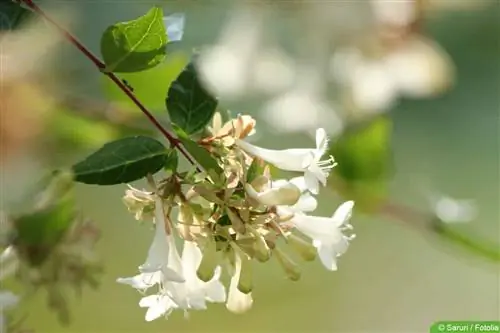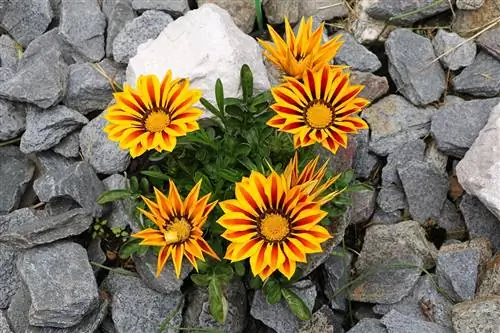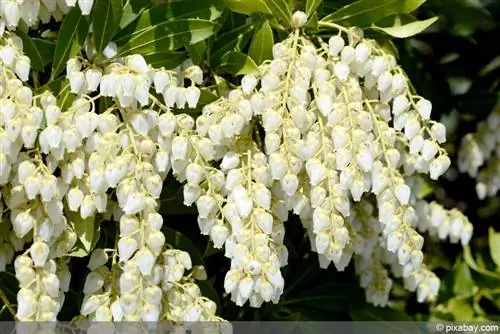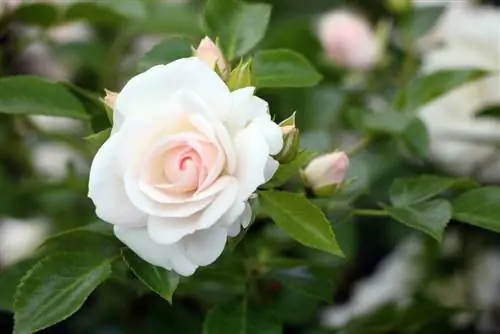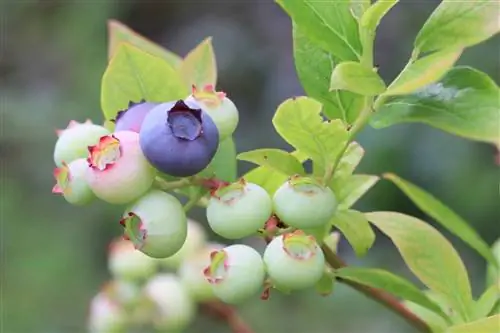- Author admin [email protected].
- Public 2023-12-17 03:39.
- Last modified 2025-01-24 12:45.
This wintergreen, low-growing flowering shrub is a summer bloomer, is almost as wide as it is tall and is also very popular with bumblebees and bees. However, not all varieties are completely hardy.
Profile
- Plant family: Honeysuckle family (Caprifoliaceae)
- Botanical name: Abelia grandiflora
- German names: Large-flowered Abalie, Abalie
- Growth: shrub-like with curved branches
- Growth height: 100-150 cm
- Foliage: dark green, ovoid, pointed
- Autumn color: orange, red
- Flowers: panicles, funnel-shaped, simple, pink-white
- Flowering period: July to September
- Lime tolerance: sensitive to lime
Site conditions
In order for Abelia grandiflora to bloom profusely, it needs a sunny location, although it also tolerates partially shaded areas. However, if it is too dark, it will only produce a few flowers and will wither over time. In addition, the location should be protected from wind. The demands on the condition of the soil are also not very high.
- Soil above all well-drained, moist and nutrient-rich
- Abalie tolerates slightly alkaline to acidic substrates
- loose, humus-rich soil with a high sand content is ideal
- Soils with a lot of clay are rather unsuitable
- as well as those with a high peat content
- also not optimal due to the addition of sand, grit or limestone
- Improve poor soils with compost
- It is better to avoid compacted soils, they tend to form waterlogging
Tip:
The topsoil (topsoil) should be at least 30 cm high. It stores water, important nutrients and filters out pollutants.
Planting time
In principle, planting is possible from spring to autumn, but preferably in spring as soon as there is no longer any risk of frost. Container plants can be planted almost all year round except in summer heat and frozen ground. On the day of planting it should be warm, dry and of course frost-free.
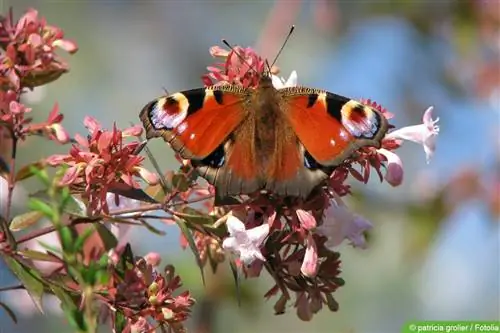
Planting instructions
- water the abalie thoroughly before planting
- Dig a sufficiently large planting pit in the meantime
- twice as wide and deep as the bale
- Enrich excavated soil with humus and compost
- pay attention to a balanced ratio of both components
- Loose up the soil in the planting hole
- Place Abalie in the middle, as deep as before in the pot
- fill with excavated earth
- Press down the soil, create a watering edge and water well
- For several copies, spacing of 150-180 cm is recommended
pot planting
Planting in a bucket is also possible without any problems and has the advantage that both the location and winter protection can be designed individually. There are a few things to consider here.
- Plant pot should not be too small
- at least 60 cm high and wide
- First provide the bucket with drainage
- fill in a part of soil
- alternating humus and potting soil
- Insert Abelia grandiflora
- fill with soil up to two centimeters below the edge
- Press substrate and water well
Pouring
This plant needs to be watered regularly from spring to autumn, depending on the weather. Water requirements are particularly high in the summer months, so daily watering is recommended. It only tolerates very short dry periods without being damaged. After a long period of heat and drought, watering should be carried out thoroughly. To prevent the soil or root area from drying out, a permanent layer of mulch can help to retain moisture in the soil for significantly longer. However, waterlogging should be avoided.
Tip:
Potted plants generally need more water because the volume is limited and the substrate dries out much more quickly. Therefore, it is important to ensure that the soil moisture remains constant and, if necessary, to water daily in hot temperatures.
Fertilize
When it comes to the supply of nutrients, fertilization should be carried out in moderation. In the bed it is usually sufficient to add some compost or humus once in the spring and again at the end of the summer. It is also possible to use a low-nitrogen complete or liquid fertilizer. You can feed potted plants with a liquid fertilizer about every two weeks or once in the spring with a slow-release fertilizer for flowering plants.
Cutting
The large-flowered Abalie usually does not need regular pruning. Nevertheless, it is very cut-resistant and can easily tolerate one or two corrective cuts if necessary. The best time for pruning is in the spring before budding begins. Shoots that are too long can be shortened and dead ones can be removed completely. This promotes more compact growth and increased flower production. Minor cosmetic corrections can be made at any time. For older specimens, rejuvenation pruning in spring can promote flowering. If the corrections are made in summer, there will usually be no flowering the following year.
Wintering
In the bed
Abelia grandiflora is hardy down to minus 15 degrees for a short time in a protected location. In most cases it cannot tolerate longer periods of frost with these temperatures. Good winter protection is therefore essential and also recommended in milder locations. Young plants are particularly at risk. To protect them, cover the planting site in autumn with a warming layer of mulch made from leaves or compost. The above-ground parts of the bushes of young plants are additionally wrapped with fleece, reed mats, bubble wrap or jute. You should water something on frost-free days and avoid fertilizing completely during the winter.
In the bucket
- It is better to keep abalie in a bucket in very rough locations
- frost-free wintering is no problem
- Winter quarters should be bright and cool
- Temperatures between five and ten degrees are optimal
- avoid excessive sunlight
- Garage or unheated winter garden ideal
- Wintering outside is also possible in milder locations
- in a protected and covered place
- best in front of a warming house wall
If the potted plant is to overwinter outdoors, this will of course not be possible without sufficient protection. Both the root area and the above-ground parts of the bush are wrapped with several layers of fleece. To protect against frost, place the bucket on an insulating surface from below, e.g. B. Styrofoam or a wooden pallet. Even in the pot, the abalie needs to be watered occasionally on frost-free days. The substrate should not dry out.
Repotting potted plants
Once the winter is over, it is the best time to repot specimens in the pot. While abalia should not be transplanted in the garden if possible, potted plants need to be transplanted regularly, i.e. every one to two years. The new bucket should only be slightly larger than the old one.
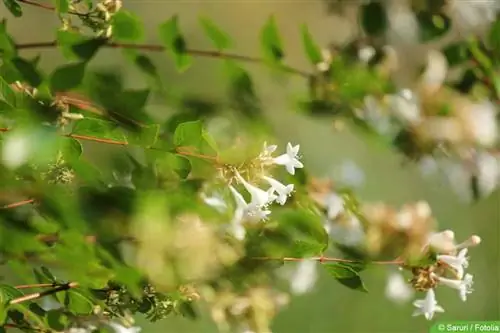
When it comes to potted plant soil, you should pay attention to high quality. The potted plant soil should contain sufficient coarse-grained, mineral components. Soil with a high peat content is not recommended. After the plant has been removed from the old pot, loose soil is removed from the ball and, if necessary, the roots are shortened slightly. Then just insert the plant and don't forget to water it.
Propagation via cuttings
Cuttings for propagation can be obtained, for example, when pruning in spring. The mother plant should of course be he althy and free of pests.
- cut half-ripe head cuttings in May
- about ten to twelve centimeters long
- remove lower leaves from cuttings
- leave the top two to three leaves on the cutting
- fill small pots with potting soil or soil-sand mixture
- insert one or more pieces per pot
- cover at least two eyes with soil
- Moisten the substrate and keep it evenly moist
- Place pots in a bright and warm place without direct sun
- Root formation has taken place when new shoots appear
- transplant into the garden after the Ice Saints
Diseases
Chlorosis
So-called chlorosis, also known as bleaching or jaundice, is a deficiency symptom. It occurs more frequently during the cold winter months. Measures to combat it are usually not necessary because it usually disappears on its own because as soon as it gets warmer again, the plant regulates the deficiency itself.
Fungal infestation
Fungal infestation occurs, for example, when the humidity is too high or too much is watered. Then you should look for a more suitable location for the plant and adjust the watering amounts to the plant's needs. In the case of a more severe infestation, the use of suitable pesticides is recommended.
Pests
The large-flowered abalie (Abelia grandiflora) is extremely resistant to pests. However, under unfavorable conditions, aphid infestations can occasionally occur. They prefer to appear in spring, especially on the fresh shoots. They can be removed with a strong jet of water, homemade soapy water or, if necessary, with a suitable insecticide.

